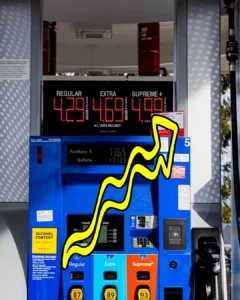It was a brutal day for the markets leaving many with retirement investments down 5% or more on top of an already poor year. On April 3rd, 2025, major indices tumbled sharply as investor anxiety surged over renewed trade tensions and tariff fears. Retirement accounts, 401(k)s, and brokerage balances across the country saw significant drops—sparking concern, confusion, and in some cases, panic selling.
Here’s how the markets ended:
- Dow Jones Industrial Average: 40,545.93, down 1,679.39 points (-3.98%)
- Nasdaq Composite: 16,550.61, down 1,050.44 points (-5.97%)
- S&P 500: 5,396.52, down 274.45 points (-4.84%)
- NYSE Composite: 18,767.19, down 765.55 points (-3.92%)
It was the worst single-day performance for the Nasdaq since October 2022. And for many investors nearing retirement—or just trying to grow wealth long-term—it raises the question:
When should you worry about your retirement investments?
Short-Term Volatility Isn’t New—And It’s Not the End of the World
While a nearly 6% drop in the Nasdaq might feel like a red flag, it’s important to zoom out. Over the past 50 years, markets have consistently rebounded from shocks, crashes, and corrections. From the dot-com bubble to the 2008 financial crisis to the pandemic-induced panic of 2020, long-term investors who stayed the course were rewarded.
2025 has been choppy. According to data from Bloomberg and MarketWatch:
- The S&P 500 is now down 9.6% YTD, flirting with correction territory.
- Tech stocks have led the decline, with some major names off more than 20% from January highs.
- Safe-haven assets like gold are up slightly, and bond yields have ticked higher as investors flee to safety.
But perspective is everything.
Why the Market Can Rebound
Here are a few reasons seasoned investors remain optimistic about their retirement investments, even after a brutal day:
1. Strong Corporate Earnings
Despite the dip, earnings forecasts for many large-cap companies remain robust. Sectors like energy, healthcare, and industrials have shown resilience, and innovation in AI and automation is still expected to drive growth through the decade.
2. The Fed Is Still Watching
While interest rates remain elevated, recent signals from the Federal Reserve suggest a possible pause—or even a cut—later in the year if inflation data continues to soften. Lower rates would provide relief to both corporate borrowers and consumers, fueling renewed market momentum.
3. Global Recovery Still in Motion
Despite trade war concerns, global GDP is expected to grow around 2.8% this year, according to the IMF. Emerging markets, especially in Asia and Latin America, are showing strong demand, creating long-term retirement investments opportunities.
4. Investor Sentiment Can Reverse Fast
Just as fear drives fast selloffs, improving news—even a resolution to trade talks—can quickly trigger a rally. Historically, some of the market’s best days follow the worst. Missing those upswings can dramatically lower long-term returns.
What Should You Do If Your Retirement Investments Just Dropped?
Here’s what not to do: panic. Rash decisions often lock in losses that would have recovered with time.
Here’s what you can do instead:
- Revisit your asset allocation. Are you too heavily weighted in tech or high-risk stocks? Diversification helps soften the blow during downturns.
- Stick to your plan. If you’re decades from retirement, time is your ally. Keep contributing to your retirement investments, especially when stocks are “on sale.”
- Consider dollar-cost averaging. Keep investing on a schedule regardless of the market. Over time, this strategy often results in better average prices.
- Talk to a financial advisor. A professional can help you understand your risk tolerance and make sure you’re positioned for both stability and growth.
History Shows Long-Term Investors Win
Here’s some comforting context from market history:
- After the 2008 financial crash, the S&P 500 dropped 56% from peak to trough. Investors who held on to their retirement investments saw a full recovery in just over four years—and more than tripled their money in the decade that followed.
- Following the COVID crash in 2020, the market recovered to new highs within six months.
- A $10,000 investment in the S&P 500 in 1980 would be worth over $1.1 million today, assuming reinvested dividends.
Final Thoughts: Now Is a Time for Patience, Not Panic
Market volatility is scary, especially when it hits close to home in retirement investments. But history, data, and smart strategy all say the same thing: stay the course.
It’s natural to feel uneasy after a big drop, but remember: short-term pain doesn’t mean long-term failure. The best investors know that time in the market beats trying to time the market—every time.




